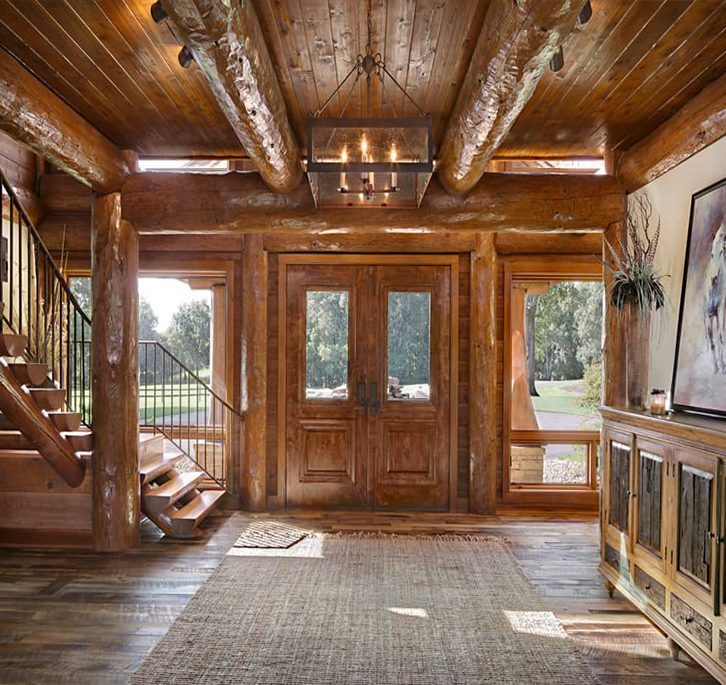
When considering the purchase of a log home, it is important to understand the unique building requirements of log homes. Of course PrecisionCraft builds to these log home standards– and always will. With over 100 years of combined experience dedicated to designing and building custom log homes, we bring significant expertise to every project. How does our knowledge, however, actually benefit you in a meaningful way? To answer this question, let us walk through several building standards unique to log homes and the PrecisionCraft methodology that relates to each. At the end, you decide if we are the right choice with whom to partner for your luxury log home.
Start Your Dream Home Today with PrecisionCraft!
Log Grading
Regardless of what kind of wood you are using, quality assurance and control matters. However, accurately grading the logs used in a log home is imperative to its structural integrity.
The Log & Timber Homes Council has a set of log grading standards accredited by the International Accreditation Service. PrecisionCraft only builds with wood that meets these exacting standards– and we provide the Certificates of Inspection to prove it. Additionally, our team always performs a thorough wood condition assessment, inspecting each shipment of logs upon its arrival at our facility. Fungi, insect damage, and slope of the grain can have the same negative impact as deterioration from moisture and other factors previously mentioned.

Logs are officially graded after the PrecisionCraft manufacturing process is complete. Thus, each milled log in your home is graded and certified as it leaves the CNC machine. If you selected handcrafted logs, grading occurs after the craftsman has completed the initial chainsaw work. When you select us for your log home, you are receiving the expertise of trusted professionals.
Energy Conservation
From your home’s foundation to your walls and your roof, energy efficient building is at the core of PrecisionCraft’s process. So committed are we to energy conservation, your home’s drawings incorporate it from the very beginning– and through each step of building. For example:
o PrecisionCraft foundations use Insulated Concrete Form (ICFs). By using ICFs in your home’s foundation, your home receives a host of benefits. These benefits include energy savings and assistance in regulating interior house temperature as well as reduced noise and air leakage. ICF usage even reduces your home’s construction time.
o PrecisionCraft uses Structural Insulated Panels (SIPs) in the roof and walls of its luxury homes. The SIPs replace the stick framing and fiberglass insulation used by so many other home builders. When combined with ICFs, your home performs 50% to 70% better than the Model Energy Code (Building Energy Codes Program, n.d.). Whether used for walls, roofs, or both, SIPs result in less energy usage. Full stop.
o We are able to maximize energy efficiency. We do this in two ways. First, we use of the highest quality materials. Second, we adhere to best practices in energy efficient construction methodology (Department of Energy , n.d.). This includes tight connections and low-e windows as well as other items as requested by our client, e.g., geothermal, solar, and more.
Additionally, if you are interested in a building LEED-certified home, let us know. We have experience designing and building homes that meet the exacting standards required by the U.S. Green Building Council. Read about LEED Certified log home projects by PrecisionCraft, including a Platinum-certification in Oregon.
Rest assured that we will incorporate energy conservation into virtually every aspect of the process as we design and build your home.
Provision For Settling
Because all log homes settle, whether they are built using milled logs or handcrafted logs, we use a patented non-settling system. Comprised of a column of steel pipe coupled with pins holding each log in place, the Houseal Non-Settling (HNS) System prevents much of the maintenance related burden associated with traditional settling log systems.
Log homes have advanced far beyond the old days of “guesstimating” settling and attempting to account for it during the construction steps of measuring, cutting, building, and even finishing. Exacting non-settling systems like the HNS are important in a log home. Through the use of the HNS, we are proud to offer the benefit of peace-of-mind to you.

Protection For Your Walls
You are probably not surprised to read it is the sun’s harmful UV rays and water, be it rain, snow, or hail, which cause the most damage to the walls of a log home. What you may not realize however, is that smart design can go a long way to mitigating this water and sun damage.
The deep eave overhangs so frequently associated with log homes? They are indeed beautiful, but they also extend the life of your home’s exterior wall stain. This is also related to the ends of those same logs, known as purlins, and their need to be protected by the eaves. As a bonus, deep eaves increase your home’s energy efficiency. Because we have our own staff of degreed architects who specialize in log, timber, and hybrid home design, you can be sure to receive a design you love in addition to one that affords protection.
You deserve a luxurious home that meets the unique standards required of log homes. Knowing log homes have different measures of evaluation than those of stick-built homes, and understanding what some of the differences are, is an important part of your research process. When you select PrecisionCraft as your luxury home partner, rest assured that the materials and methods used in your residence are world class.
Notes
________________________________________
Building Energy Codes Program. (n.d.). Retrieved from U.S. Department of Energy
Department of Energy . (n.d.). Retrieved from Public Services
